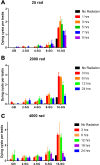Germ cell connectivity enhances cell death in response to DNA damage in the Drosophila testis
- PMID: 28809158
- PMCID: PMC5577909
- DOI: 10.7554/eLife.27960
Germ cell connectivity enhances cell death in response to DNA damage in the Drosophila testis
Abstract
Two broadly known characteristics of germ cells in many organisms are their development as a 'cyst' of interconnected cells and their high sensitivity to DNA damage. Here we provide evidence that in the Drosophila testis, connectivity serves as a mechanism that confers to spermatogonia a high sensitivity to DNA damage. We show that all spermatogonia within a cyst die synchronously even when only a subset of them exhibit detectable DNA damage. Mutants of the fusome, an organelle that is known to facilitate intracyst communication, compromise synchronous spermatogonial death and reduces overall germ cell death. Our data indicate that a death-promoting signal is shared within the cyst, leading to death of the entire cyst. Taken together, we propose that intercellular connectivity supported by the fusome uniquely increases the sensitivity of the germline to DNA damage, thereby protecting the integrity of gamete genomes that are passed on to the next generation.
Keywords: D. melanogaster; DNA damage; developmental biology; fusome; germ cell cyst; germ cells; stem cells.
Conflict of interest statement
Reviewing editor,
No competing interests declared.
Figures
















Similar articles
-
Germline cyst formation in Drosophila.Annu Rev Genet. 1997;31:405-28. doi: 10.1146/annurev.genet.31.1.405. Annu Rev Genet. 1997. PMID: 9442902 Review.
-
Visualizing Fusome Morphology via Tubulin Immunofluorescence in Drosophila Ovarian Germ Cells.Methods Mol Biol. 2023;2626:135-150. doi: 10.1007/978-1-0716-2970-3_7. Methods Mol Biol. 2023. PMID: 36715903 Free PMC article.
-
Orbit/CLASP is required for germline cyst formation through its developmental control of fusomes and ring canals in Drosophila males.PLoS One. 2013;8(3):e58220. doi: 10.1371/journal.pone.0058220. Epub 2013 Mar 8. PLoS One. 2013. PMID: 23520495 Free PMC article.
-
Asymmetric germ cell division and oocyte determination during Drosophila oogenesis.Int Rev Cytol. 2001;203:93-138. doi: 10.1016/s0074-7696(01)03005-4. Int Rev Cytol. 2001. PMID: 11131529 Review.
-
Regeneration of male germline stem cells by spermatogonial dedifferentiation in vivo.Science. 2004 May 28;304(5675):1331-4. doi: 10.1126/science.1097676. Epub 2004 May 13. Science. 2004. PMID: 15143218
Cited by
-
Molding immortality from a plastic germline.Curr Opin Cell Biol. 2021 Dec;73:1-8. doi: 10.1016/j.ceb.2021.04.010. Epub 2021 Jun 3. Curr Opin Cell Biol. 2021. PMID: 34091218 Free PMC article. Review.
-
Apoptosis in the fetal testis eliminates developmentally defective germ cell clones.Nat Cell Biol. 2020 Dec;22(12):1423-1435. doi: 10.1038/s41556-020-00603-8. Epub 2020 Nov 16. Nat Cell Biol. 2020. PMID: 33199844 Free PMC article.
-
rDNA magnification is a unique feature of germline stem cells.Proc Natl Acad Sci U S A. 2023 Nov 21;120(47):e2314440120. doi: 10.1073/pnas.2314440120. Epub 2023 Nov 15. Proc Natl Acad Sci U S A. 2023. PMID: 37967216 Free PMC article.
-
Subcellular Specialization and Organelle Behavior in Germ Cells.Genetics. 2018 Jan;208(1):19-51. doi: 10.1534/genetics.117.300184. Genetics. 2018. PMID: 29301947 Free PMC article. Review.
-
Enhancer of polycomb maintains germline activity and genome integrity in Drosophila testis.Cell Death Differ. 2018 Aug;25(8):1486-1502. doi: 10.1038/s41418-017-0056-5. Epub 2018 Jan 23. Cell Death Differ. 2018. PMID: 29362481 Free PMC article.
References
-
- Brodsky MH, Weinert BT, Tsang G, Rong YS, McGinnis NM, Golic KG, Rio DC, Rubin GM. Drosophila melanogaster MNK/Chk2 and p53 regulate multiple DNA repair and apoptotic pathways following DNA damage. Molecular and Cellular Biology. 2004;24:1219–1231. doi: 10.1128/MCB.24.3.1219-1231.2004. - DOI - PMC - PubMed
Publication types
MeSH terms
Grants and funding
LinkOut - more resources
Full Text Sources
Other Literature Sources
Molecular Biology Databases

